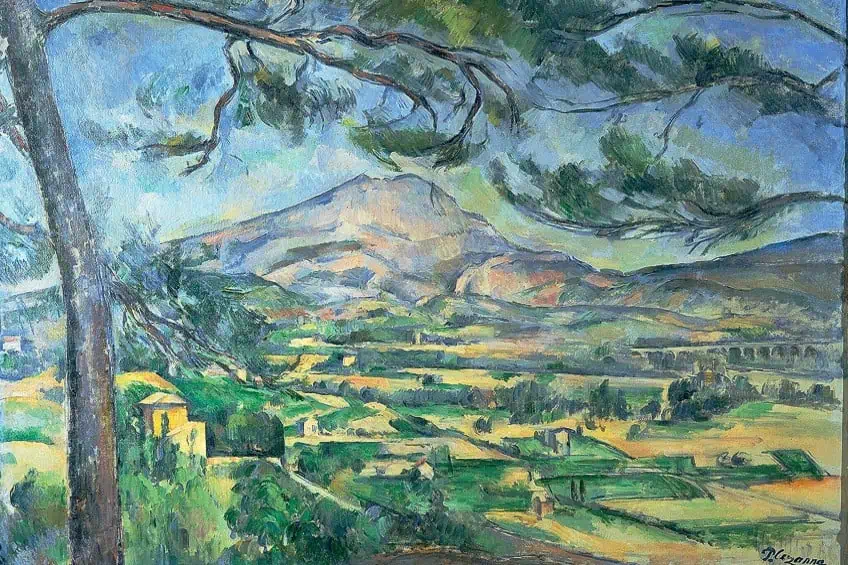“Mont Sainte Victoire” by Paul Cézanne – Analysis of the Series
Mont Sainte Victoire, a towering mountain peak located in southern France, has captured the imaginations of artists for centuries. One of the most celebrated depictions of this majestic mountain comes from the brush of French Post-Impressionist painter Paul Cézanne. His series of paintings, which depict Mont Sainte Victoire from a variety of angles and perspectives, are considered to be some of the most influential works in the history of art. In this article, we will delve into a Mont Sainte Victoire analysis to explore the unique techniques and insights that Cézanne brought to his portrayal of this iconic landmark.
Artist Abstract: Who Was Paul Cézanne?
Paul Cézanne was a French Post-Impressionist painter who lived from 1839 to 1906. He is widely regarded as one of the most influential artists of the 19th century, and his work paved the way for the development of modern art movements such as Cubism and Fauvism.

Cézanne’s unique approach to painting, which emphasized the use of bold, geometric shapes and a vibrant color palette, challenged the traditional art world and paved the way for a new era of artistic experimentation. His landscapes and still-life paintings, including his famous series of Mont Sainte Victoire, continue to inspire artists and art enthusiasts around the world today.
Mont Sainte Victoire by Paul Cézanne
| Date | 1870 – 1906 |
| Medium | Oil on canvas |
| Dimensions (cm) | Various |
| Style | Post-Impressionism |
| Type | Landscape |
| Subject | Mont Sainte Victoire mountain |
| Location | Various |
Before we do a Mont Sainte Victoire analysis, we will contextualize this series within the larger socio-political juncture in France. We will also look at the context of Cézanne’s career and how his explorations at the time led him to create this powerful series of landscape paintings.
Mont Sainte Victoire by Paul Cézanne in the French Socio-Political Context
Paul Cézanne’s Mont Sainte Victoire series was created during a time of great social and political change in France. The late 19th century saw the rise of Impressionism and other avant-garde art movements, which challenged the traditional academic style that had dominated the French art world for centuries.
Cézanne’s work was at the forefront of this artistic revolution, and his Mont Sainte Victoire series marked a turning point in the history of landscape painting.
At the same time, France was undergoing significant changes on the political front. The country had just emerged from the devastating Franco-Prussian War, which had led to the fall of the Second French Empire and the establishment of the Third French Republic. This period was marked by a renewed sense of nationalism and a desire to restore France’s cultural and artistic prestige in the world.

Cézanne’s paintings reflected this changing social and political climate in a number of ways. For one, his use of bold, vibrant colors and dynamic compositions was a departure from the more traditional landscape painting style that had been popular in France for centuries. This break from tradition was emblematic of the broader cultural shift that was taking place in French society, as artists and intellectuals sought to break free from the constraints of the past and embrace new forms of expression.
Additionally, Cézanne’s emphasis on the natural world and his celebration of the beauty and majesty of the French landscape reflected the growing sense of national pride and cultural identity that was taking hold in France during this period.
The Mont Sainte Victoire series can be seen as a tribute to the enduring power of the French landscape and a celebration of the country’s unique cultural heritage.
Mont Sainte Victoire by Paul Cézanne Within the Context of His Career
Paul Cézanne’s Mont Sainte Victoire series, comprised of multiple paintings of the same mountain, was painted by Cézanne between 1882 and 1906. The series marked a turning point in Cézanne’s career, as he began to explore new techniques and styles that would come to define his later work.
At the time he began the Mont Sainte Victoire series, Cézanne was already a well-established artist with a significant body of work behind him.
He had spent much of his career experimenting with different styles and techniques and had gained a reputation as a talented but somewhat controversial figure in the art world. Despite his talent, Cézanne had struggled to achieve commercial success and had only recently begun to gain wider recognition for his work.
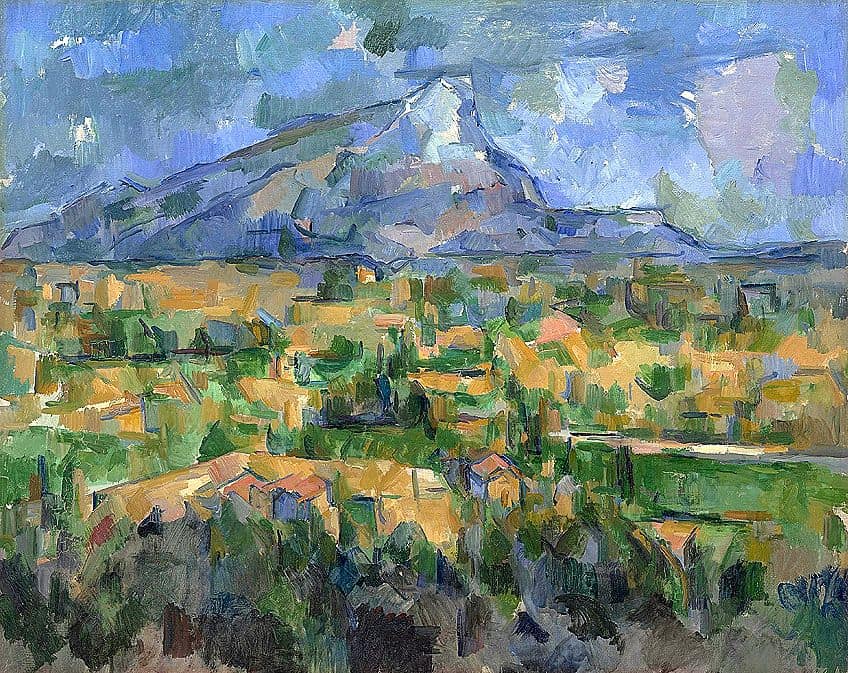
The Mont Sainte Victoire series was inspired by Cézanne’s lifelong fascination with the natural world. He was drawn to the mountain for its unique geological features and the way it caught the light at different times of day. He began painting the series in a new style, characterized by bold brushwork and a flattened perspective that rejected traditional notions of perspective and composition. The Mont Sainte Victoire series had a profound influence on Cézanne’s later work. He continued to explore new techniques and styles, and his paintings became increasingly abstract and expressive.
His use of color also became more vibrant and experimental, as he experimented with different ways of capturing the natural world on canvas.
Reception of the Mont Sainte Victoire Series
Paul Cézanne’s Mont Sainte Victoire series is now considered one of the most important achievements in the history of landscape painting. However, the series was not always so well-regarded. When the paintings were first exhibited in Paris in 1895, they were met with a mixed reception from both critics and the public. The exhibition took place at the Galerie Bernheim-Jeune, one of the most prominent galleries in Paris at the time.
The series was presented as a unified whole, with each painting offering a slightly different perspective on the iconic mountain that dominates the landscape of Provence.
At the time of the exhibition, Cézanne was already a well-established figure in the French art world, and his work had been shown in a number of prominent exhibitions. However, the Mont Sainte Victoire series represented a departure from his earlier style, and many critics were unsure how to respond. One of the most vocal critics of the series was Gustave Geffroy (1855-1926), who wrote for the influential magazine La Nouvelle Revue. Geffroy was a leading figure in the French art world, and his opinions carried significant weight. In his review of the exhibition, Geffroy praised Cézanne’s “powerful and intense vision” but also expressed reservations about the series’ lack of traditional composition and perspective.

Other critics were more positive in their assessments. Octave Mirbeau (1848-1917), writing for Le Figaro, called the Mont Sainte Victoire series “a triumph of color” and praised Cézanne’s ability to capture the nuances of light and shadow in the landscape. Despite the mixed reception, the exhibition was a critical turning point for Cézanne’s career.
The Mont Sainte Victoire series marked a new phase in his development as an artist, and the paintings would go on to influence generations of artists in the years to come.
Mont Sainte Victoire Analysis
Mont Sainte Victoire is a series composed of over 30 paintings that is known for its unique approach to landscape painting that emphasized the use of bold, geometric shapes and a vibrant color palette. At the core of the series is Cézanne’s exploration of the relationship between form and color, and his use of these elements to create a dynamic and compelling visual experience for the viewer.
Subject Matter
The subject matter of the Mont Sainte Victoire series is, of course, the mountain peak itself. However, Cézanne’s approach to this subject matter is far from traditional. Rather than simply depicting the mountain as it appears in reality, Cézanne breaks down its form into a series of geometric shapes and planes. This approach allows him to capture the essence of the mountain, rather than simply its physical appearance.
The series also features a number of different perspectives on the mountain, with some paintings featuring a close-up view of the peak, while others show the mountain in the distance, surrounded by fields and trees.
Color and Light
Color and light play a significant role in the Mont Sainte Victoire series. Cézanne’s use of color is bold and vibrant, with bright greens, blues, and yellows dominating many of the paintings. He also uses color to create depth and dimensionality, with warm colors often being used to bring objects forward in the painting, while cool colors are used to push them back. The play of light across the mountain is also a key feature of the series, with Cézanne using light to create texture and to highlight the different planes of the mountain’s form.
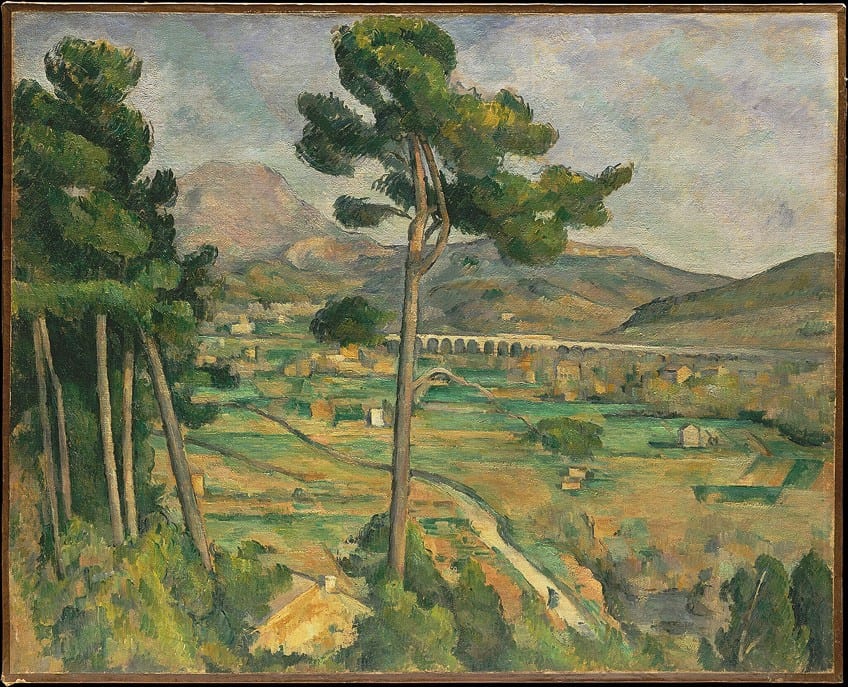
Texture
Texture is another important element of the Mont Sainte Victoire series. Cézanne’s use of thick, impasto brushstrokes gives the paintings a sense of depth and texture that invites the viewer to explore the surface of the canvas.
He also uses texture to differentiate between the different planes of the mountain, with rougher textures being used to depict the rocky, jagged peaks, while smoother textures are used for the surrounding fields and trees.
Perspective
Perspective is a key element of the Mont Sainte Victoire series. Cézanne’s use of different perspectives on the mountain creates a sense of dynamism and movement that draws the viewer into the painting. The use of different angles and viewpoints also allows him to explore the relationship between form and space, and to create a sense of depth and dimensionality that is often lacking in traditional landscape paintings.
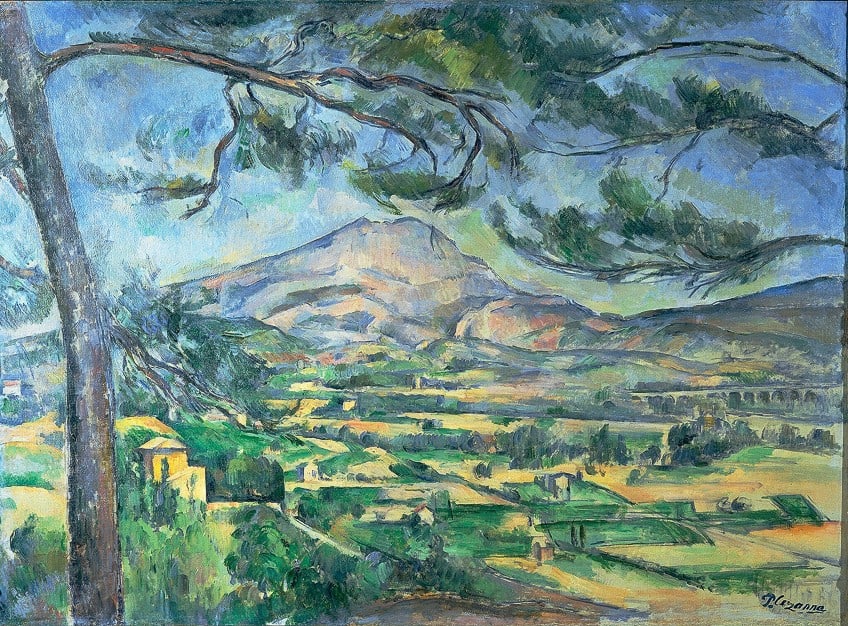
Symbolism
Finally, the symbolism in the Mont Sainte Victoire series is both subtle and profound. For Cézanne, the mountain was more than just a physical landmark; it was a symbol of the enduring power and majesty of nature. Through his paintings, he sought to capture this essence and convey a sense of awe and wonder at the natural world.
The series is also a testament to Cézanne’s own artistic vision and his tireless pursuit of a new form of expression that would revolutionize the art world.
The Legacy of Mont Sainte Victoire
Paul Cézanne’s Mont Sainte Victoire series had a profound influence on the development of Cubism, one of the most important art movements of the 20th century. Cubism was characterized by the fragmentation of form and the rejection of traditional notions of perspective and composition, and it was heavily influenced by Cézanne’s innovative approach to painting. Cézanne’s use of color and his exploration of different ways of capturing the natural world on canvas were particularly influential on the Cubist movement.
His flattened perspective and the way he broke down forms into their component parts provided a blueprint for the Cubist approach to composition, which emphasized the fragmentation of form and the deconstruction of traditional subjects.
Artists such as Georges Braque (1882 – 1963) and Pablo Picasso (1881 – 1973) were particularly inspired by Cézanne’s work, and they began to experiment with similar techniques and styles. They embraced the flattened perspective and the use of color to create abstracted forms, and they began to break down traditional subjects into their component parts, creating a new visual language that emphasized the complexity and multiplicity of the world.
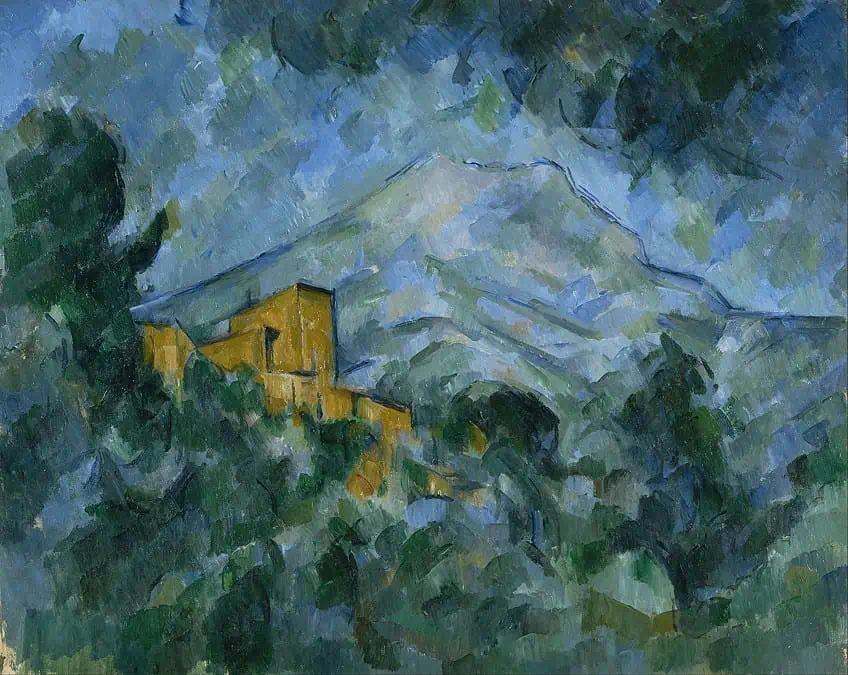
The influence of Cézanne’s Mont Sainte Victoire series can be seen in some of the most important works of Cubism, including Picasso’s Les Demoiselles d’Avignon (1907) and Braque’s Houses at L’Estaque (1908). These works were characterized by the same flattened perspective and abstracted forms that defined Cézanne’s work, and they demonstrated the influence that the Mont Sainte Victoire series had on the development of modern art.
In conclusion, Paul Cézanne’s Mont Sainte Victoire series is a remarkable achievement that transformed the landscape painting genre and had a lasting impact on the development of modern art. The series marked a turning point in Cézanne’s career, as he explored new techniques and styles that would come to define his later work. Through the Mont Sainte Victoire series, Cézanne demonstrated a deep understanding of the natural world and an innovative approach to painting that rejected traditional notions of perspective and composition. Today, the series is regarded as one of the most significant achievements in the history of painting, and a key work in Cézanne’s career.
Frequently Asked Questions
Why Was Paul Cézanne Such an Influential Artist?
Paul Cézanne became famous due to his innovative approach to painting, which challenged traditional notions of perspective, composition, and color. He sought to capture the natural world in a new and unique way, breaking down forms into their component parts and experimenting with flattened perspectives and bold color schemes. His work paved the way for many important art movements of the 20th century, including Cubism and Fauvism, and his influence can be seen in the work of countless artists who followed in his footsteps.
What Is the Political Relevance of Mont Sainte Victoire by Paul Cézanne?
Paul Cézanne’s Mont Sainte Victoire series was a product of the social and political changes that were taking place in France during the late 19th century. Through his bold use of color, dynamic compositions, and celebration of the natural world, Cézanne captured the spirit of a nation in transition, and his work remains a testament to the enduring power of art to reflect and shape the world around us.
How Was Mont Sainte Victoire by Paul Cézanne Received When It Was First Exhibited?
The first exhibition of Paul Cézanne’s Mont Sainte Victoire series was a pivotal moment in the history of landscape painting. While the series was met with a mixed reception from critics and the public, it represented a significant departure from traditional landscape painting and set the stage for the development of new artistic movements in the years to come. Today, the Mont Sainte Victoire series remains a testament to Cézanne’s mastery of color and his innovative approach to capturing the natural world on canvas.
Nicolene Burger, a South African multimedia artist and creative consultant, specializes in oil painting and performance art. She earned her BA in Visual Arts from Stellenbosch University in 2017. Nicolene’s artistic journey includes exhibitions in South Korea, participation in the 2019 ICA Live Art Workshop, and solo exhibitions. She is currently pursuing a practice-based master’s degree in theater and performance. Nicolene focuses on fostering sustainable creative practices and offers coaching sessions for fellow artists, emphasizing the profound communicative power of art for healing and connection. Nicolene writes blog posts on art history for artfilemagazine with a focus on famous artists and contemporary art.
Learn more about Nicolene Burger and about us.
Cite this Article
Nicolene, Burger, ““Mont Sainte Victoire” by Paul Cézanne – Analysis of the Series.” artfilemagazine – Your Online Art Source. October 17, 2023. URL: https://artfilemagazine.com/mont-sainte-victoire-by-paul-cezanne/
Burger, N. (2023, 17 October). “Mont Sainte Victoire” by Paul Cézanne – Analysis of the Series. artfilemagazine – Your Online Art Source. https://artfilemagazine.com/mont-sainte-victoire-by-paul-cezanne/
Burger, Nicolene. ““Mont Sainte Victoire” by Paul Cézanne – Analysis of the Series.” artfilemagazine – Your Online Art Source, October 17, 2023. https://artfilemagazine.com/mont-sainte-victoire-by-paul-cezanne/.


